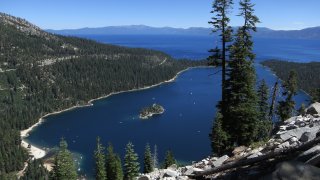
Lake Tahoe’s fluctuating clarity got worse last year during an especially cold and wet winter as sedimentation, algae growth and a tiny invasive shrimp continued to pose restoration challenges for the famed clear water of the mountain lake straddling the California-Nevada line.
The clarity decline came a year after lake had showed clarity improvement from its worst level in a half-century as climate change continues to drive long-term trends, with rising air temperatures and less precipitation falling as snow, according to the UC Davis Tahoe Environmental Research Center.
A white, dinner plate-sized disc used to measure clarity was visible at an average depth of 62.7 feet (19 meters) in 2019. That’s down from 70.9 feet (21.6 meters) measured in 2018.
While the average annual clarity is better than it was in previous decades, it's still short of the current restoration target of 97.4 feet (30 meters) set by state and federal regulators, the research center said in Thursday’s release of its annual “State of the Lake Report.”
Get a weekly recap of the latest San Francisco Bay Area housing news. Sign up for NBC Bay Area’s Housing Deconstructed newsletter.
Scientists hope efforts to combat threats to the lake's clarity posed by development and climate change will eventually return Lake Tahoe to its historical clear depth of 100 feet (30 meters).
The lake's cobalt waters exceeded that at one point in 2019, reaching a maximum depth of 112 feet (34 m) on Feb. 19. Last year’s worst reading of 36.1 feet (11 m) was recorded on May 8, coinciding with an algae bloom.
The scientists said the data reinforces the need to continue to expand efforts to remove the invasive shrimp. Introduced to the lake in the 1960s, Mysis shrimp are driving out native zooplankton that keep the water clear by consuming algae and other small particles.
California
Last year’s precipitation was a foot (30 centimeters), more than the average of the past 110 years. Average air temperature in February 2019 was several degrees lower than the long-term average — and it was the coldest February since 1956.
The average surface water temperature of 68 degrees (20C) in 2019 was down from 72 degrees (22C) in 2017.
But the surface water temperature in Lake Tahoe has generally been on the rise since at least 1968, when regular measurements began.
Warmer temperatures have already reduced the percentage of annual precipitation that comes in the form of snow from about 50% 100 years ago to around 30% today, which means warmer water flows into the lake.
The lake's clarity was at its best when levels were first recorded in 1968, with an average depth of 102.4 feet (31.2 meters). The disc typically was visible at depths of 85 feet (30 meters) or deeper through the 1970s.
The lake's clarity levels registered their worst performance during a severe drought in the late 1990s.



